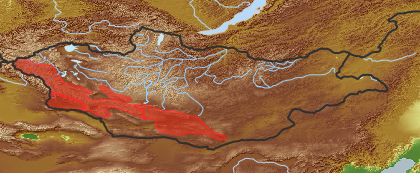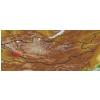| Class: | angiosperms |
| Order: | Boraginales |
| Family: | Boraginaceae |
| Genus: | Lindelofia |
| Scientific name: | Lindelofia stylosa (Kar. et Kir.) Brand |
| Name acc. to: | Gubanov 1996 |
| Herbar: | list records  |
| Link to Flora of China: | http://www.efloras.org/browse.aspx?flora_id=2&name_str=Lindelofia+stylosa |
| open map in a new window |  |
| Habitat: | Slopes and bottom of sayrs, steppe stony slopes, bottom of ravines (Grubov 2001). |
| Habit (i)general appearance of a plant | |
| Growth form: (i)Herb, shrub, tree or climber. | herb (i)Herbaceous, erect plant, up to 2m high, mostly with a leafy shoot; if perennial, shoots die to the ground each season, shoots are not woody
example: Artemisia pectinata   inherited by family Boraginaceae: herb inherited by family Boraginaceae: herb
|
| Parasite status: (i)Is the plant a half- or full parasite? | no parasite/saprophyte (i)Plant fully autonomous, leaves with chlorophyll
example: Most plants, Ranunculus  inherited by family Boraginaceae: no parasite/saprophyte inherited by family Boraginaceae: no parasite/saprophyte
|
| Water or terrestrial plant: (i)Where do the plants grow? | terrestrial (i)Plant grows on dry land
example: Orostachys spinosa  inherited by family Boraginaceae: terrestrial inherited by family Boraginaceae: terrestrial
|
| Leaf (i)expanded, usually photosynthetic organ of a plant (including phylloclades) | |
| Leaf development: (i)Structure and development of leaves. | with green leaves (i)Plant with green leaves  inherited by family Boraginaceae: with green leaves inherited by family Boraginaceae: with green leaves
|
| Leaf arrangement: (i)Arrangement of leaves at the stem. | alternate (i)One leaf per node; distiche: arranged in two vertical rows, equitant
example: Phragmites    inherited by family Boraginaceae: alternate inherited by family Boraginaceae: alternate
|
| Simple or divided leaves: (i)Are the leaves simple or completely divided in several parts? Blade of the leaf entire or (more or less) deeply dissected. Attention: There are various appearances of the leaf margin (from entire to toothed and lobed). Here, we ignore this and ask only for dissections that separate the leaf for more than one third of its length or width, whatever is smaller. Sometimes, it is difficult to tell apart compound leaves from a shoot system with simple leaves: look for stipulae and/or axillary buds at the ground of the leaves: if only some possess these structures, the others are most likely leaflets of a compound leaf. | simple (i)Non-divided leaf, but margin may be incised nearly to the ground   inherited by family Boraginaceae: simple inherited by family Boraginaceae: simple
|
| Leaf margin: (i)Structure of leaf margin (or that of a leaflet in case of compound leaves). Attention: Here we ask for the leaf margin, defined as all those dissections that separate the leaf for less than one third of its length or width, whatever is smaller. To be worked out: how to handle margin of pinnate leaves? | entire (i)Plain margin, not toothed
example: Iris   inherited by family Boraginaceae: entire inherited by family Boraginaceae: entire
|
| Stipule: (i)Leaflets at the base of the petiole, these are smaller and of different shape. | none (i)Without stipules
example: Euphorbia, Ericaceae s.l.  inherited by family Boraginaceae: none inherited by family Boraginaceae: none
|
| Leaf veination: (i)Arrangement of the main veins of a leaf. | pinnate (i)One main vein, several side veins, sometimes inconspicuous
example: Cicerbita     inherited by family Boraginaceae: pinnate inherited by family Boraginaceae: pinnate
|
| Flower (i)reproductive portion of the plant, consisting of sepals, petals, stamens, and pistils | |
| Flower appearance and pollination: (i)General appearance of the flower. | attractive, animal-pollinated (i)attractive and coloured flowers, mostly large, attracting surely animals
example: Trollius, Rosa, Chamaerhodos  inherited by family Boraginaceae: attractive, animal-pollinated inherited by family Boraginaceae: attractive, animal-pollinated
|
| Perianth arrangement: (i)Attention: in some plants, flowers may be dimorphic in different ways (dioecious or gynodioecious). If flowers vary, record the characters of the most showy flowers. | double, different (i)Two types of perianth leaves, differently coloured (sepals: outer periant leaves, usually greenish, and petals: inner perianth leaves, usually coloured)
example: Parnassia    inherited by family Boraginaceae: double, different inherited by family Boraginaceae: double, different
|
| Flower symmetry: (i)Symmetry of the perianth leaves. Attention: to assess this character, look on sepals, petals and stamens, but neglect carpels and ovary. | radiary, regular (actinomorphic) (i)More than two axis of symmetry
example: Saxifraga: 5; Iris: 3   inherited by family Boraginaceae: radiary, regular (actinomorphic) inherited by family Boraginaceae: radiary, regular (actinomorphic)
|
| Flower form: (i)common forms of flowers ? Veronica | tubular to funnel-shaped (i)Petals form a tube, are often partially united to a cylindrical corolla, often surrounded by a calyx   inherited by family Boraginaceae: tubular to funnel-shaped inherited by family Boraginaceae: tubular to funnel-shaped
campanulate (i)Petals united to a bell-shaped corolla   inherited by family Boraginaceae: campanulate inherited by family Boraginaceae: campanulate
|
| Sepal number: (i)Number of sepal leaves (outer perianth leaves, calyx leaves, mostly greenish). Attention, this character applies only for flowers separated in sepals and petals, thus excluding most monocots. Be aware of the bracts (involucral leaves) of Asteraceae flowerheads, do not qualify these as sepals! Be also aware in Rosaceae is often an epicalyx developed, in this case count all parts. | 5 (i)
example: Polemonium  inherited by family Boraginaceae: 5 inherited by family Boraginaceae: 5
|
| Sepal fusion: (i)To which degree are the sepal leaves connected? Attention, this character applies only for flowers separated in sepals and petals, thus excluding most monocots. Be aware of the bracts (involucral leaves) of Asteraceae flowerheads, do not qualify these as sepals! | fused (i)Leaves united, only tips are free
example: Fabaceae, Silene    inherited by family Boraginaceae: fused inherited by family Boraginaceae: fused
|
| Petal / Tepal number: (i)Number of petal leaves (inner perianth leaves, usually coloured). | 5 (i)
example: Potentilla  inherited by family Boraginaceae: 5 inherited by family Boraginaceae: 5
|
| Petal / Tepal fusion: (i)To which degree are the petal leaves connected? Petals sympetalous. | fused (i)petal leaves united, only tips are free (gamopetalous, sympetalous)
example: Linnaea, Adenophora, Stellera  inherited by family Boraginaceae: fused inherited by family Boraginaceae: fused
|
| Spur: (i)A hollow, slender, sac-like appendage of the perianth leaves, storing nectar. | no spur (i)Flower without appendage
example: Peganum  inherited by family Boraginaceae: no spur inherited by family Boraginaceae: no spur
|
| Stamen number: (i)Attention: We ask for the reproductive organs of the flower dispersing pollen. Count only fully fertile stamens, not staminodia (e.g. Parnassia). | 5 (i)
example: Peucedanum  inherited by family Boraginaceae: 5 inherited by family Boraginaceae: 5
|
| Stamen fusion: (i)To which degree are the stamens fused? Attention: Whereas the pollen sacs itself are often free., their stalks (filaments) may be fused. Here, we count them as fused if they are together over at least one thirth of their length. | fused with a corolla (calyx in Thymelaeaceae) (i)Stamens with perianth leaves at least one third of the length of the filament
example: Orobanche, Salvia, Stellera  inherited by family Boraginaceae: fused with a corolla (calyx in Thymelaeaceae) inherited by family Boraginaceae: fused with a corolla (calyx in Thymelaeaceae)
|
| Carpel number: (i)Number of carpels (carpel: forming a simple pistil or part of a compound pistil, modified leaf). | 2  inherited by family Boraginaceae: 2 inherited by family Boraginaceae: 2
|
| Carpel fusion: (i)To which degree are the carpels (modified leaf forming simple pistil or part of a compound pistil) fused. | fused (i)Carpels united into an ovary, only styles are free
example: Malus, Berberis  inherited by family Boraginaceae: fused inherited by family Boraginaceae: fused
|
| Style number: (i)Portion of the pistil connecting the stigma to the ovary. | 1  inherited by family Boraginaceae: 1 inherited by family Boraginaceae: 1
|
| Ovary position: (i)For entirely or partly fused carpels, describe their position in relation to the insertion point of perianth leaves (best done by doing a longitudinal section of a flower). | superior (hypogynous) (i)Base of carpels attached above insertion point of perianth leaves, carpels free or fused
example: Delphinium, Anemone    inherited by family Boraginaceae: superior (hypogynous) inherited by family Boraginaceae: superior (hypogynous)
|
| Sex: (i)Distribution of male and female organs among flowers, only most commonly cases. | bisexual, hermaphrodite (i)All or nearly all flowers of a plant with male and female parts
example: Haplophyllum, Chenopodium  inherited by family Boraginaceae: bisexual, hermaphrodite inherited by family Boraginaceae: bisexual, hermaphrodite
|
| Fruit (i)the seed bearing organ, with or without adnate parts; a ripened ovary and any other structures which are attached and ripen with it. Aggregate fruits are handled like simple fruits for determination. | |
| Consistency: (i)Fleshy fruits or dry fruits, see dispersal adaptations for further classification. | dry (i)With a dry outer shell, no fleshy parts, but seed (embryo) could be edible  inherited by family Boraginaceae: dry inherited by family Boraginaceae: dry
|
| Type of fruit: (i)Common fruit types (including pseudocarp). | Indehiscent fruits  inherited by family Boraginaceae: Indehiscent fruits inherited by family Boraginaceae: Indehiscent fruits
Solitary fruits (i)     inherited by family Boraginaceae: Solitary fruits inherited by family Boraginaceae: Solitary fruits
nut or nutlet (i)Dry fruit with a single, hard stone inside (and usually a large often edible embryo)   inherited by family Boraginaceae: nut or nutlet inherited by family Boraginaceae: nut or nutlet
|
| Splitting of fruit: (i)Is a solitary fruit splitting into fruitlets? The fruit splits into separate one-seeded segments at maturity (schizocarp). | splitting  inherited by family Boraginaceae: splitting inherited by family Boraginaceae: splitting
in 4 parts (i)
example: Boraginaceae, Lamiaceae   inherited by family Boraginaceae: in 4 parts inherited by family Boraginaceae: in 4 parts
|
| Size of fruit: (i)Size of the fruit including appendage. | to 5 mm (i)
example: Halerpestes: many folicles forming dry nutlets  inherited by family Boraginaceae: inherited by family Boraginaceae:
from 5 mm to 10 mm (i)
example: Silene: small capsule opening with teeth  inherited by family Boraginaceae: inherited by family Boraginaceae:
|
| Dispersal: (i)Appearance of fruit or seed (if single) and adaptations to dispersal. | Otherwise (i)All parts dry, no conspicuous adaptations  inherited by family Boraginaceae: Otherwise inherited by family Boraginaceae: Otherwise
|
| Seed number: (i)Estimate the number of seeds per fruit, if recognizable seeds are in the fruit (in rare cases a fruit may contain one seeded nuts: rose hip, carex). | 2-6 (i)2-6 single seeds, well recognizable
example: Crataegus: few-seeded berry  inherited by family Boraginaceae: 2-6 inherited by family Boraginaceae: 2-6
|
| Hairs | |
| Has hairs?: | has hairs  inherited by family Boraginaceae: has hairs inherited by family Boraginaceae: has hairs
|
| Hairs: (i)Appearance, structure, coverage of hairs on plant. | appearance: stiff (i)Hairs stiff but not pungent, erect
example: Lappula  inherited by family Boraginaceae: appearance: stiff inherited by family Boraginaceae: appearance: stiff
on stem/shoot (i)Has hairs on stem/shoot  inherited by family Boraginaceae: on stem/shoot inherited by family Boraginaceae: on stem/shoot
|
| Root / shoot below ground (i)plant part below ground (in most cases), including below ground shoots, without leaves | |
| Root type: (i)Organisation of the roots. | allorhizous (i)Plant with a conspicuous tap root, one larger tap root with side roots
example: Dicotyledonae  inherited by order Boraginales: allorhizous inherited by order Boraginales: allorhizous
|
| Distribution (i)region where the plant is likely to be found | |
| Distribution (Veg. Zones): (i)acc. to Grubov 1952 | Mongolian Altai (i)In distribution data often named as '7' 
Gobi-Altai (i)In distribution data often named as '13' 
Dzungarian Gobi (i)In distribution data often named as '14' 
acc. to: Gubanov 1996 |